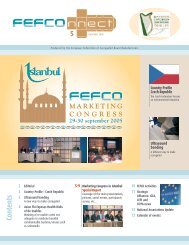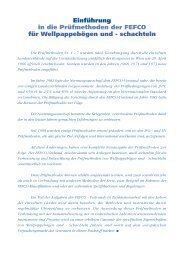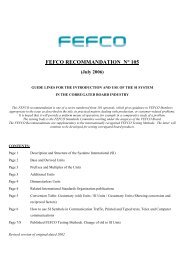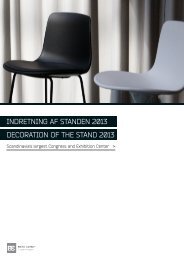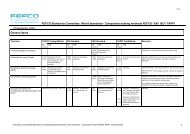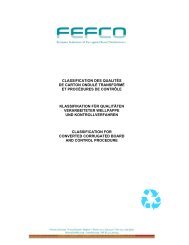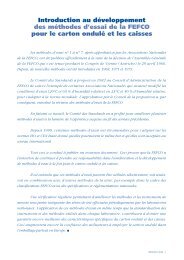Read - Fefco
Read - Fefco
Read - Fefco
You also want an ePaper? Increase the reach of your titles
YUMPU automatically turns print PDFs into web optimized ePapers that Google loves.
Health & Safety Measures in the Netherlands:<br />
Lesson to Learn<br />
Sharing best Practices within the industry<br />
Many member companies of FEFCO consider H&S issues to be one of the most<br />
important items on their internal agendas. Health of employees is important<br />
because companies are obliged to do everything to prevent work accidents;<br />
incurrences always mean cost, as well as having a bad impact both on image and<br />
moral.<br />
Toon Schrijver,<br />
Vereniging Golfkarton<br />
Companies have a wide variety of tools<br />
at their disposal, and one of these is<br />
information on past accidents; learning in<br />
detail about the nature of an accident that<br />
has already occurred gives you the chance to<br />
take precautions in your own plant or office<br />
environment.<br />
Associations play a major role in<br />
dissemination of information. Therefore,<br />
FEFCO has taken the initiative to encourage<br />
members to exchange more details of<br />
accidents that happen in their own plants.<br />
Human nature means that people are more<br />
likely to cover up mistakes (key cause of<br />
many accidents), rather than disclose them,<br />
which is why establishing a good information<br />
exchange might need time and the power of<br />
persuasion to take effect. However, FEFCO<br />
strongly believes that reducing accidents in<br />
our plants will in the long run be a major<br />
benefit for the industry.<br />
In some countries, exchange systems already<br />
exist. FEFCO will build upon these, and to<br />
6 FEFCOnnect 30<br />
find out what has been achieved already at<br />
national level, we talked to Toon Schrijver,<br />
Secretary General of the Dutch Association<br />
of Corrugated Industries, who runs one of<br />
the oldest of all such exchange systems in<br />
Europe.<br />
Toon, when and why did your<br />
association decide to establish an<br />
information system on accidents?<br />
The system started in the early 2000’s, for a<br />
couple of reasons: We as an industry realised<br />
that the situation in many plants was unsafe,<br />
there were too many accidents, and the<br />
authorities were beginning to get involved.<br />
Three associations (Corrugated, Paper &<br />
Board and Flexible Packaging), Trade Unions,<br />
and the authorities started working on a<br />
programme to improve the safety of our<br />
plants.<br />
Were there legal obligations that<br />
supported the start of the system?<br />
There was a “soft” push from the<br />
government, in a very supportive way,<br />
which is typical of the way we work in<br />
the Netherlands: the parties developed<br />
and signed a covenant; the Government<br />
supported the initial 4-5 years with personal<br />
and financial input. Even in the later stages,<br />
the authorities refrained from creating special<br />
legislation, recognising that the industry was<br />
already introducing improvements without<br />
new laws being introduced. There is a strong<br />
belief in Dutch society and by the authorities<br />
that this can be best done by the industry<br />
itself, not by the government. The new<br />
Health and Safety Act leaves much room for<br />
self regulation.<br />
What were your initial steps?<br />
The initial step was to create a programme<br />
and to formulate goals and issues, such as<br />
safety of machinery, noise reduction, and<br />
safety of personnel. Initial steps included<br />
the inspection of all machines for possible<br />
risks, and the development of tools for<br />
improvement. Noise turned out to be a very<br />
complex issue and noise reduction was very<br />
costly. The goal was to have a noise level<br />
below 80 decibels everywhere in the plant,<br />
or otherwise have a programme of hearing<br />
protection. Our industry developed a system<br />
for the members in order to compare the<br />
benefits of going one way or the other. That<br />
system, including a "noise reduction factor",<br />
was even awarded at European level by DG<br />
SANCO. One more example of the initial<br />
phase was the inclusion of work-related<br />
stress, measured through a medical system<br />
that obliged the companies to take action<br />
if the result was below a certain level. That<br />
system continues today.<br />
Which components are parts of your<br />
exchange system today?<br />
We try to cover all areas that could mean a<br />
health or safety risk, such as:<br />
• Noise reduction<br />
• Solvents<br />
• Heat stress<br />
• Physical loads<br />
• Converting machines risk assessment and<br />
solutions<br />
• Manual threading (process of feeding<br />
paper into corrugators)<br />
• Corrugators Internal transportation<br />
• Work space design (set-up)<br />
• Confined spaces<br />
• Fall prevention<br />
• Lockout Tagout Tryout (LTT)<br />
• Work stress i.e. harassement at work<br />
• Hazardous materials



